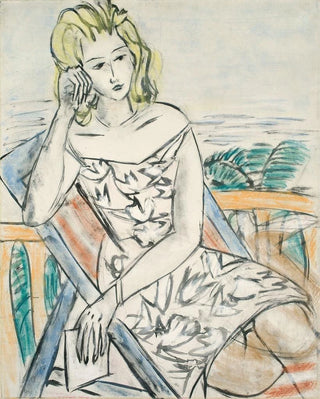Art print | Portrait of a young girl - Max Beckmann


View from behind

Frame (optional)
Portrait of a Young Girl - Max Beckmann – Captivating Introduction
The "Portrait of a Young Girl" by Max Beckmann is a work that embodies the richness and complexity of 20th-century art. Created in a style that blends expressionism and realism, this piece immediately draws the eye, captivating the viewer with its intensity and mystery. The face of the young girl, both delicate and powerful, seems to tell a story that transcends time. This artwork, emblematic of the artist's quest for identity, offers a profound reflection on youth, innocence, and the tumult of the human soul. Through this art print, the viewer is invited to immerse themselves in a universe where each brushstroke reveals an emotion, and each color illuminates a facet of life.
Style and uniqueness of the work
What makes the "Portrait of a Young Girl" particularly striking is how Beckmann manages to capture the very essence of his subject. The facial features, accentuated by carefully balanced shadows and lights, create rare psychological depth. The color palette, both vibrant and subtle, evokes an atmosphere that is at once gentle and unsettling. Beckmann, a master of light and shadow, succeeds in bringing his model to life, transforming the portrait into a true dialogue between the viewer and the artwork. The eyes of the young girl, full of life and mystery, seem to invite introspection, a meeting with her own emotions and memories. This portrait is not just a representation; it is an immersive experience that resonates deeply with those who take the time to observe it.
The artist and his influence
Max Beckmann, an emblematic figure of modern art, knew how to mark his era with his bold style and unique vision. Born in 1884 in Leipzig, he experienced the upheavals of the 20th century, which undeniably influenced his work. Beckmann always sought to express the complexity of the human condition, using his art as a means of reflection on social and personal crises. His innovative approach to portraiture, which combines realism and abstraction, opened new paths for artistic expression. Through

Matte finish

View from behind

Frame (optional)
Portrait of a Young Girl - Max Beckmann – Captivating Introduction
The "Portrait of a Young Girl" by Max Beckmann is a work that embodies the richness and complexity of 20th-century art. Created in a style that blends expressionism and realism, this piece immediately draws the eye, captivating the viewer with its intensity and mystery. The face of the young girl, both delicate and powerful, seems to tell a story that transcends time. This artwork, emblematic of the artist's quest for identity, offers a profound reflection on youth, innocence, and the tumult of the human soul. Through this art print, the viewer is invited to immerse themselves in a universe where each brushstroke reveals an emotion, and each color illuminates a facet of life.
Style and uniqueness of the work
What makes the "Portrait of a Young Girl" particularly striking is how Beckmann manages to capture the very essence of his subject. The facial features, accentuated by carefully balanced shadows and lights, create rare psychological depth. The color palette, both vibrant and subtle, evokes an atmosphere that is at once gentle and unsettling. Beckmann, a master of light and shadow, succeeds in bringing his model to life, transforming the portrait into a true dialogue between the viewer and the artwork. The eyes of the young girl, full of life and mystery, seem to invite introspection, a meeting with her own emotions and memories. This portrait is not just a representation; it is an immersive experience that resonates deeply with those who take the time to observe it.
The artist and his influence
Max Beckmann, an emblematic figure of modern art, knew how to mark his era with his bold style and unique vision. Born in 1884 in Leipzig, he experienced the upheavals of the 20th century, which undeniably influenced his work. Beckmann always sought to express the complexity of the human condition, using his art as a means of reflection on social and personal crises. His innovative approach to portraiture, which combines realism and abstraction, opened new paths for artistic expression. Through






